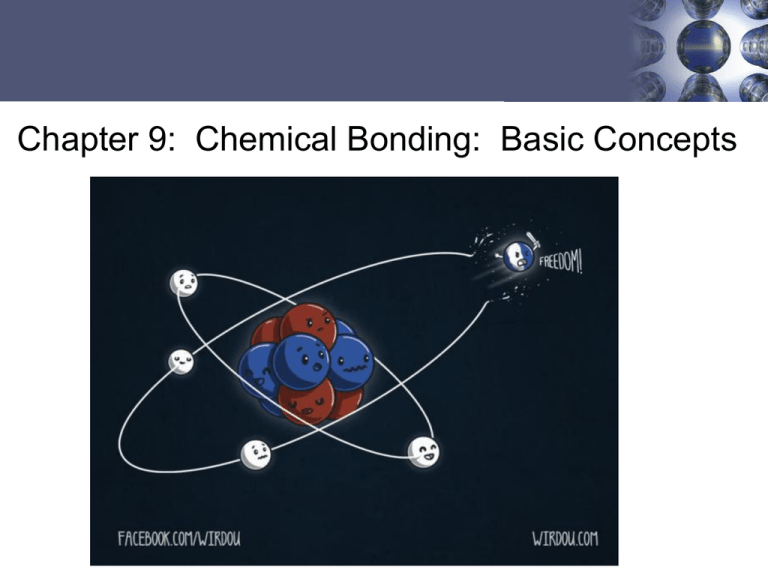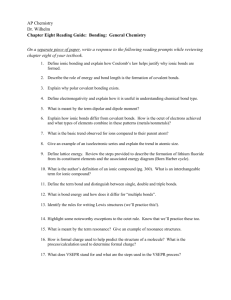
Section 8.1
Types of Chemical Bonds
Chapter 9: Chemical Bonding: Basic Concepts
Section 8.1
Chemical
Bonds Bonds
Types
of Chemical
▪ Forces that hold groups of atoms together and make them
function as a unit.
▪ A bond will form if the energy of the compound formed is
lower than that of the separated atoms.
Copyright © Cengage Learning. All rights reserved
Section 8.1
Types of Chemical Bonds
All chemical reactions involve making
and breaking chemical bonds.
▪ Bond formation always releases energy
▪ Bond breaking always requires energy
Section 8.1
I won the Nobel Prize
in Chemistry and the
Types of Chemical Bonds
Nobel Peace Prize
Electronegativity:
▪ The ability of an atom in a molecule
to attract shared electrons to itself.
▪ The most widely accepted method
for determining values of
electronegativity was derived by
Linus Pauling.
▪ The range of electronegativity values
is from 4.0 for fluorine (the most
electronegative) to 0.7 for cesium
(the least electronegative).
Copyright © Cengage Learning. All rights reserved
Electronegativity is the ability of an atom to attract
toward itself the electrons in a chemical bond.
Electron Affinity - measurable, Cl is highest
X-(g)
X (g) + e-
Electronegativity - relative, F is highest
H
electron poor
region
F
electron rich
region
5
Section 8.1
Types of Chemical Bonds
The electronegativity increases across a period:
▪ Same energy level, but the number of protons
increases which increases the effective nuclear
charge.
The electronegativity decreases going down a group
▪ As more energy levels are added, the size of the
atoms increases. The effective nuclear charge is
not as great due to shielding.
Copyright © Cengage Learning. All rights reserved
Section 8.1
Types of Chemical Bonds
CONCEPT CHECK!
If lithium and fluorine react, which has more attraction
for an electron? Why?
▪ Fluorine has a greater nuclear pull. Both are in the
same energy level, but F has more protons. More
protons, greater nuclear attraction
In a bond between fluorine and iodine, which has more
attraction for an electron? Why?
▪ Fluorine has a greater nuclear pull. Although iodine
has a greater nuclear charge, the charge is being
‘shielded’ by the increase in energy levels.
Copyright © Cengage Learning. All rights reserved
Section 8.1
Types of Chemical Bonds
As the different in electronegativity increases:
-bond polarity increases
-ionic character increases
Covalent
Polar Covalent
share e-
partial transfer of e-
Ionic
transfer e-
Section 8.1
Types of Chemical Bonds
Three major type of intermolecular bonds can be described
by the electronegativity difference
1. Covalent (non-polar covalent): Bond difference 0-0.4
▪ electrons are shared equally
2. Polar Covalent: Bond difference 0.4 → 1.9
▪ Bond becomes increasingly polar with higher values;
▪ electrons shared unequally
3. Ionic: Bond difference greater than 1.9
▪ Large difference; Bond becomes more ionic in nature ;
electron transfer can occur.
Section 8.1
Types of Chemical Bonds
Put the following bonds in order of increasing ionic
character. Predict the type of bond each will incur.
H-Cl H-F
H-H
H-O
H-S
NP
Cov
NP
Cov
P
Cov
P
Cov
Ionic
Section 8.1
Types of Chemical Bonds
EXERCISE!
Arrange the following bonds from most to least polar:
a) N–F
b) C–F
c) Cl–Cl
a) C–F,
b) Si–F,
c) B–Cl,
Copyright © Cengage Learning. All rights reserved
O–F
N–O
B–Cl
N–F,
C–F,
S–Cl,
C–F
Si–F
S–Cl
O–F
N–O
Cl–Cl
Section 8.1
Types of Chemical Bonds
CONCEPT CHECK!
Which of the following bonds would be the least
polar yet still be considered polar covalent?
Mg–O C–O O–O Si–O N–O
Copyright © Cengage Learning. All rights reserved
Section 8.1
Types of Chemical Bonds
CONCEPT CHECK!
Which of the following bonds would be the most
polar without being considered ionic?
Mg–O C–O O–O Si–O N–O
Copyright © Cengage Learning. All rights reserved
Section 8.1
TypesofofChemical
ChemicalBonds
Bonds
Types
1.
Ionic Bonding
▪ Electrons are transferred
▪ Metal and nonmetal react: ions form so that both ions
achieve noble gas configurations (usually) resulting in an
electrostatic attraction of oppositely charged ions
▪ Any compound that conducts an electric current when
melted will be classified as ionic.
Section 8.1
TypesofofChemical
ChemicalBonds
Bonds
Types
Metals lose electrons to achieve noble gas configurations.
Non-metals gain electrons to achieve noble gas
configurations.
The Ionic Bond
Ionic bond: the electrostatic force that holds ions together in an
ionic compound.
Li+ F Li + F
1s22s1
LiF
1s22s22p5
Li+ + e-
Li
e- +
Li+ +
1s2 1s22s22p6
[He]
[Ne]
F
F -
F -
Li+ F -
16
Section 8.1
Types of Chemical Bonds
Ex: Explain how atoms of sodium and oxygen form an ionic
compound using their electron configurations
Na: 1s22s22p63s1
O: 1s22s22p4
Oxygen has a higher electronegativity(the ability to attract an
electron), so electrons are transferred from sodium to
oxygen. Oxygen needs 2 electrons, so 2 sodium atoms are
needed. Na2O is formed.
2Na → 2Na+ + 2e-
O + 2e- → O2-
Na+: 1s22s22p6
O2-: 1s22s22p6
Section 8.1
Types of Chemical Bonds
Lewis Structure (Electron Dot Diagrams)
▪ A simplistic way of showing the reactive electrons (the
valence electrons) of an atom.
▪ Reflects central idea that stability of a compound relates
to noble gas electron configuration.
Copyright © Cengage Learning. All rights reserved
Section 8.1
Electron dot structures
Types of Chemical Bonds
Draw the Lewis structure for each of the following:
1. O
2. Li
3. S
4. O25. Ca2+
Section 8.1
Types of Chemical Bonds
Use the electron dot structure to show how Na and O
can become an ion
Na
→
Na+
+
sodium Ion
Sodium atom
e1 electron
2-
O
Oxygen atom
+
2e2 electrons
→
O
Oxide Ion
Section 8.1
Showof
the
formation
of Na2O using Lewis structures
Types
Chemical
Bonds
[ ]
[ ]
Na2O
Section 8.1
Types of Chemical Bonds
▪ Show the formation of (A) calcium fluoride and
(B) aluminum oxide using electron-dot structures
Section 8.1
Lattice
Types
ofenergy
Chemical Bonds
Lattice (Electrostatic) Energy
▪ Lattice energy, is the energy release that occurs when
separated gaseous ions are packed together to form an
ionic solid (lattice crystal)
Xx+(g) + Yy-(g) → XyYx(s) + energy
Ex: Na+(g) + Cl-(g) → NaCl(s) + 7787.3 kJ
Ho= -787.3 kJ/mol
▪ Lattice energy indicates how strongly the ions attract
each other in the solid state.
Section 8.1
Coulomb’s
Law Bonds
Types
of Chemical
We can calculate the lattice energy of an ionic compound by
using Coulomb’s Law:
E = (2.31 x 10-19 J·nm) x Q1Q2
r
k = proportionality constant =2.31 x 10-19 J·nm
Q1 and Q2 = charges on the ions
r = distance between the ion centers in nm
Lattice energy increases as Q increases and/or as r decreases.
A negative sign indicates an attractive force!
Section 8.1
Lattice
trend
Types
ofenergy
Chemical
Bonds
▪ Charge on ions: The greater the charge on the
ions, the stronger the ionic bond
▪ Radius or size of ion: If the charges are equal, the
smaller ion will have the stronger ionic bond.
Section 8.1
Types of Chemical Bonds
How does lattice energy effect melting point?
Section 8.1
Types of Chemical Bonds
Example: Which would you predict has the most
exothermic lattice energy: NaCl or KCl? Explain.
Answer: NaCl
▪ Both NaCl and KCl all have +1 or -1 charges.
▪ Since Na+ is smaller than K+, the distance, r, is
less, making the energy more.
▪ As this energy increases, the strength and stability
of the crystal lattice increases.
Section 8.1
Types of Chemical Bonds
Example: In solid sodium chloride, the distance between
the centers of the Na+ and Cl- ions is 2.76Å. Determine
the ionic energy per pair of ions. (1m = 1010Å).
E = (2.31 x 10-19 J·nm) x Q1Q2
r
E = (2.31 x 10-19 J·nm) x (+1)(-1)
0.276nm
= -8.37 x 10-19 J
The negative sign indicates an attractive force. The
ion pair has LOWER energy than the separated ions.
Section 8.1
Types of Chemical Bonds
▪ Coulomb’s law can also be used to calculate the
repulsive energy when two like charged ions are
brought together. This energy will have a positive
sign.
Example: The interaction of two hydrogen atoms
▪ The hydrogen atoms will position themselves so
that the system will achieve the lowest possible
energy.
▪ The distance where energy is minimal is called the
bond length.
Section
PHET 8.1
Types of Chemical Bonds
The Interaction of Two Hydrogen Atoms: the molecule is
more stable than two separated hydrogen atoms by a
certain quantity of energy.
Copyright © Cengage Learning. All rights reserved
Section 8.1
Types of Chemical Bonds
End Lesson 1








